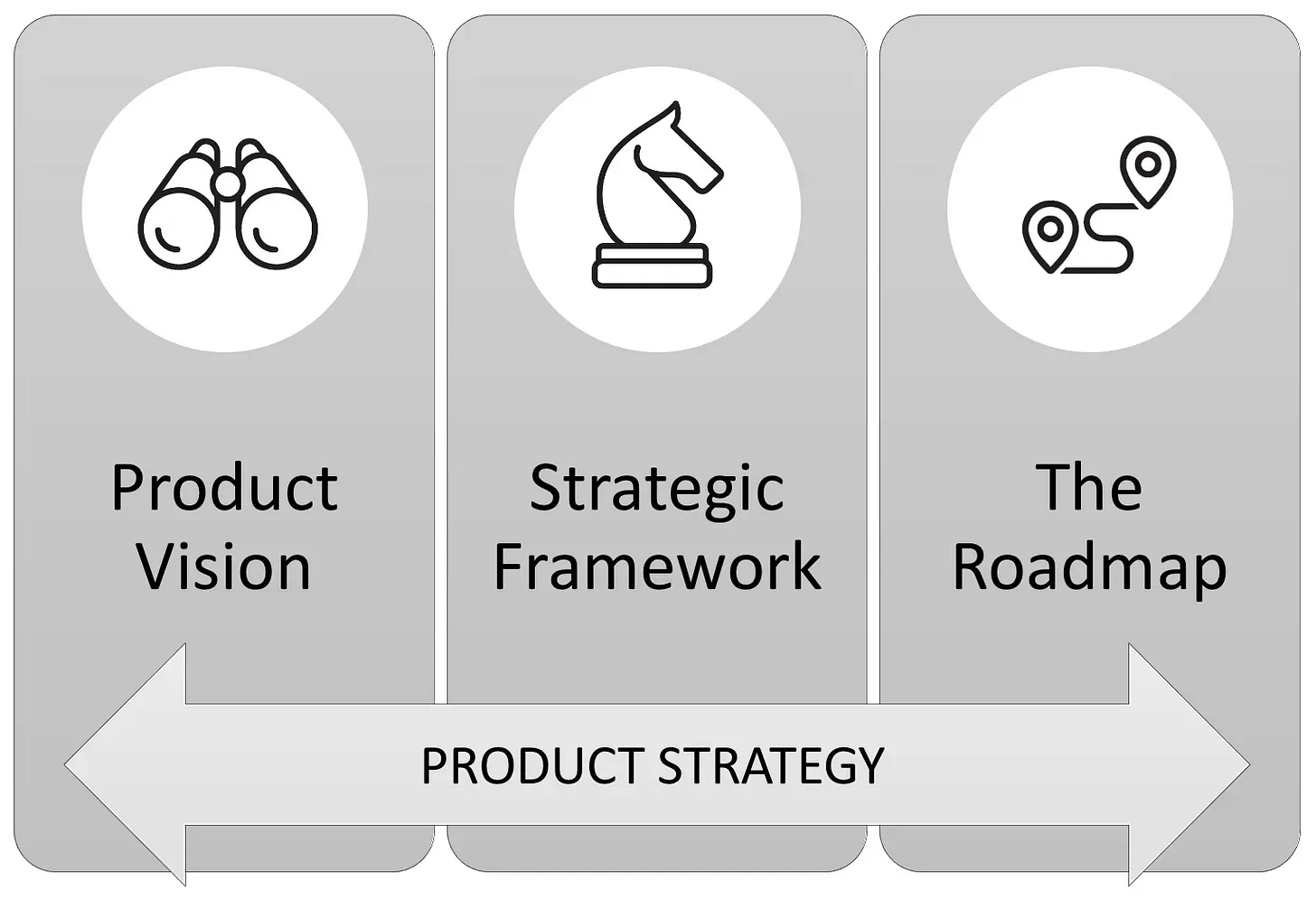Have you ever seen a great product flop? This happens all too often which shows us that even the best products don't always win. It doesn't matter how well-designed the product is or how quickly you move if you are going in the wrong direction.
"If you don't know where you are going, you'll end up someplace else." - Yogi Berra
This underscores the importance of developing a sound product strategy to set your product up for success by analyzing key components like vision, frameworks, and roadmaps, then identifying ways to optimize them. This means proactively seeking feedback from stakeholders, tracking market trends, evaluating risks, and gaining insights to chart a clear, focused direction.
💁♀️ Tip: The ability to develop cohesive strategies that resonate with users and effectively guide teams is an invaluable product management capability.
What it means to be strategic

Being strategic means mapping out a long-term product vision and execution plan. It requires analyzing the market landscape to anticipate future needs. A strategic outlook defines an ambitious product vision, setting attainable goals, and aligning your team to move confidently in that direction.
Early in your career you will execute strategy set by product leaders. Over time you will need to expand your strategic skills to spot opportunities and define a new vision. This means researching markets, setting ambitious goals beyond existing plans, and mapping long-term roadmaps that will link your efforts to bold outcomes.
💁♀️ Tip: Strong communication aligns stakeholders to the strategy. A strategic product manager doesn't just implement, but formulates vision and rallies their team towards a future they shape and lead.
Plotting the Product Roadmap: What Strategic Thinking Means for Product Managers
A key part of a product manager's role is to take a strategic, long-term view of the product vision and roadmap. This involves thinking beyond immediate demands to chart a course for the product's future success and growth.
For product managers, being strategic means:
- Maintaining focus on the big-picture goals and customer needs, not just short-term feature requests
- Researching market and industry trends to identify future opportunities and challenges
- Finding strategic gaps or weaknesses in the product lineup and determining how to address them
- Building alignment across stakeholders on the product roadmap priorities
- Balancing tradeoffs between different technology options or strategic choices
- Anticipating future needs and changes to get ahead of the curve
- Adjusting the roadmap as new information emerges while still guiding the product toward its strategic goals
The product manager is ultimately responsible for the strategy behind what gets built and why. By taking a strategic perspective, product managers can guide the product vision while executing tactically to bring that vision to reality
Product Strategy
Product strategy encompasses 3 components: the product vision, the strategic framework, and the roadmap. Often times when there is confusion it's because one of these is missing.

Typically, the CEO or head of product sets the overarching product strategy for the entire company. Directors then develop more targeted strategies for their specific groups. Individual product managers create the most focused strategies for their specific teams and products, aligning with the broader organizational strategy.
Strategies will become increasingly detailed and narrow in scope as they funnel from the executive level down to individual contributor product managers responsible for execution.
The Product Vision
A product vision is the future of the product. A great product vision will include specific details, insights and opinions that make the future vision clear and inspiring to teams. But what makes a strong Product Vision?
A compelling product vision includes:
- Strategic foresight - Looks beyond immediate needs and sees the future potential. Considers industry trends and market trajectory.
- Customer centricity - Focuses on solving problems for target users. Aligns to customer needs and desires.
- Purpose and meaning - Has an aspirational purpose. Rallies the team around meaningful goals.
- Clear direction - Defines where the product is headed and why it matters. Gives a clear path forward.
- Ambition - Sets a bold, inspiring target that stretches the limits of what's possible.
- Adaptability - Flexible to adjust as circumstances evolve while staying focused on the north star.
- Viability - Ambitious yet grounded in reality. Considers constraints and competitive landscape.
- Differentiation (has a hook) - Carves out a unique positioning compared to alternatives.
- Memorable messaging - Communicated succinctly and inspire teams.
An effective product vision provides a North Star, beacon of hope, light and structure to move teams forward in a focused, motivated way. It captures the future potential and rallies everyone around bringing that potential to life.
🚨 Important: Notice that your product vision provides the 'what' and 'why.'
The Strategic Framework
A strategic framework provides the blueprint and requirements for an effective strategy that drive product success and achieve business outcomes. A well-designed strategic framework will guide product direction and bring discipline and structure by translating vision into strategic plans. This means a high-level overview of the goals and principles of the strategy as well as the target market.
Here are some tips for creating an effective strategic framework:
- Research frameworks and best practices from reputable sources as a starting point. Build on proven methodology.
- Ensure major strategic planning components are included - market analysis, vision setting, goal planning, gap analysis, opportunity assessment, etc.
- Outline a logical sequence of steps and planning phases. Order matters.
- Incorporate tools like SWOT analysis, Jobs-to-be-Done, where appropriate. Leverage analytical tools.
- Have a phase focused on longer-term vision setting and opportunity identification. Don't just look at current state.
- Include ways to get broad input and alignment across departments. Collaboration is key.
- Build in prioritization of strategic initiatives based on importance, viability, resources required.
- Define process for creating roadmap and key milestones for executing the strategy.
- Have clear guidance for measuring progress and outcomes with metrics and KPIs. Trackability matters.
- Develop guidelines for adapting framework as new information emerges. Agility is essential.
- Keep framework organized, easy to navigate, with visuals to enhance clarity. Simplicity enables usage.
The strategic framework should provide a practical guide that product teams can consistently apply to formulate effective strategies tailored to their specific context and needs.
The Roadmap

A product roadmap is a high-level visual plan that outlines the strategic initiatives, priorities and timelines required to achieve the product vision. It provides a rough timeline of when things are expected to be achieved.
Why have a roadmap? It helps to show the steps needed to achieve the product vision. A product roadmap is a critical alignment, planning, and communication tool that outlines strategic initiatives on a timeline to guide teams towards achieving product goals. It translates strategy into executable plans, coordinates resources, provides visibility into upcoming releases, maintains focus on the vision, and serves as a guidepost for decision making while allowing for agility. The roadmap is essential for aligning the organization, tracking progress, and sharing product direction transparently across stakeholders.
Here are some tips for creating an effective product roadmap:
- Align to company strategy and key business goals
- Incorporate market analysis, research, and competitive evaluation
- Define timeline with short, medium, and long-term views
- Organize strategic themes and initiatives into measurable roadmap items
- Include all cross-functional initiatives, not just engineering features
- Show stage gates, dependencies, and milestones
- Have clear prioritization principles to sequence items
- Build in flexibility to adapt as circumstances evolve
- Keep high-level, avoid granular feature detailing
- Maintain visual design for clarity and rapid communication
- Socialize roadmap across teams and stakeholders early and often
- Set cadence for regular roadmap reviews and updates
- Use supporting documents to provide details as needed
- Track progress regularly and update status clearly
The roadmap should provide a holistic, adaptable plan that motivates the organization around strategic priorities and transparently communicates direction.
Creating a Product Strategy
When creating a product strategy it's important to make it a collaborative process and get buy-in from stakeholders. Most stakeholders won't be deeply involved in the creation of the strategy, but they should feel like they are a part of the overall process. This will help provide the support you need to deliver and execute on your roadmap.
Shift your mindset
Often times you may not have time for the things you want to accomplish. Prioritizing will help with this, but also shifting your mindset will be pivotal. Making time for strategic work is just as important as making time for designers and engineers. You wouldn't choose one over the other as you need both to facilitate good work. The same applies for strategic work. Make the shift from solely focusing on your team to focusing on the overall company initiatives. Change your perspective from focusing solely on your product to considering the broader organizational strategy and cross-functional objectives.
The importance of strategic work-Blue Sky opportunities
There will always be tradeoffs and when you make time for other things you have to think about the tradeoffs you are making. By not realizing the importance of strategic work, important opportunities can be missed.
Blockbuster is a prime example. Strategically wise they kept going in iterations and listening to customer feedback and continuing to improve on their products and offering promotions, etc. But they didn't work on bigger opportunities and bigger strategic. So when the digital space was evolving and streaming was in it's infancy they didn't think to start working towards this. What ended up happening? Well, Blockbuster went under.
Blockbuster exemplifies the risks of sound execution without strategic foresight. They iterated efficiently, listened to customers, and promoted their offerings - but focused incrementally without looking into other future opportunities. When digital streaming emerged, Blockbuster lacked the strategic vision to pivot. Rather than capitalizing on industry shifts, they clung to dated assumptions. In the end, the absence of long-term strategic thinking left Blockbuster unable to adapt to new realities. They failed to envision and plan ambitiously for the future, focusing myopically on optimizing current operations. Blockbuster proves why execution must be complemented with bold strategic thinking to drive innovation and sustain success.
Continually encourage teams to explore innovative directions and keep them engaged by identifying opportunities to lead the markets rather than follow the trend.
Working with quick approaches for a small team
Strategies shouldn't take a long time. A lot of people are fearful when they heard the word 'strategy.' There are different ways to look at creating a strategy.
Here are some quick approaches when creating a strategy for a small team:
- Host a brainstorming session to generate strategic ideas
- Interview cross-functional partners for insights on opportunities
- Analyze market and user data to identify improvement areas
- Define 3 strategic focus themes/initiatives
- Create a lightweight roadmap outlining priorities for next 1-2 quarters
The key is to rapidly align through collaborative ideation, rather than crafting an elaborate strategy. Quickly focus team efforts in the highest potential areas and start executing. Refine as you go.
Creating a Broader Strategy for a bigger group
Having a smaller team it is easier to draft a strategy by yourself and share it among the team for feedback. With larger teams, the stakes are higher, the teams are bigger, politics become more apparent so it's important to cross-functionally collaborate even more.
Here is a concise step-by-step process for collaboratively creating a product strategy:
- Align on Mission - Set overall company or team objectives, key results expected, and mission to align around.
- Ideate Strategically - Brainstorm ideas as a team to identify opportunities, priorities, and strategic focus areas.
- Prioritize Initiatives - Facilitate collaborative discussion to evaluate and prioritize proposed initiatives based on expected impact, available resources, capabilities.
- Map Strategic Themes - Outline high-level strategic initiatives and group them into 2-3 coherent themes.
- Set Measurable Goals - For each theme, define 1-2 specific, quantitative, time-bound goals for success.
- Build A Collaborative Roadmap - Create an integrated roadmap outlining prioritized strategic initiatives over a timeline and assign owners.
- Communicate and Rally - Clearly share the strategy across stakeholders and ensure understanding to build alignment.
- Empower Execution - Provide support to team members and empower them to autonomously operationalize the initiatives they own.
- Review and Refine - Set a cadence for evaluating progress, celebrating wins, and adjust course as learnings emerge.
Communicate and Promote It

Formulating a strategy is only half the battle. Equally important is effectively communicating the strategy to gain understanding and alignment across the organization. After leadership approves the strategy, develop a comprehensive plan for sharing it clearly with stakeholders. Don't just announce the strategy, but continually reinforce it so people internalize what it means for their work.
Advocating for the strategy also involves generating excitement and commitment. Inspire teams by connecting the strategy to their aspirations and painting a vivid picture of the future it will create. With persistent, skillful communication and advocacy, you can rally the organization around the new direction, driving deeper buy-in and eagerness to execute on the strategy.
Here are some ideas for effectively communicating and generating excitement for a product strategy:
- Create a compelling narrative - Connect the strategy to the organization's purpose and values. Paint a vivid picture of the future vision. (Become a master at story telling.)
- Use simple, consistent messaging - Make the strategy into easy-to-remember themes, slogans, or frameworks. Repeat often.
- Share early and engage input - Socialize strategy with key stakeholders early in the process to build ownership.
- Customize delivery for each audience - Tailor communications and value proposition for specific teams or functions.
- Leverage multiple channels - Cascading info sessions, small group discussions, FAQs, Slack announcements, emails, posters.
- Spotlight benefits and wins - Highlight how the strategy benefits users and delivers wins for the business and employees.
- Incorporate into rituals - Integrate strategy communication into existing meetings, reviews, and activities.
- Lead by example - Executives and leaders modeling behaviors aligned to the strategy.
- Make it visual and concrete - Bring strategy to life through roadmaps, mockups, videos, presentations.
- Provide forums for feedback - Create channels for stakeholders to offer input and feel heard.
Consistently communicating the strategy will help to reinforce the company's strategic initiatives and objectives. There is no such thing as over-communicating and if you ever feel you are just know this is a positive. It takes work to make sure a strategy can stick and people are behind it. Never underestimate the importance and value of communication.
Final Words 📖
An effective product strategy is invaluable. It requires a compelling vision, strategic framework, and roadmap. The vision inspires, the framework provides details, the roadmap outlines execution. Together they show where you are heading, why it matters, and how to get there.
Remember, without strategic alignment, even strong teams will struggle to maximize impact. There is little value in dedicated efforts lacking direction. Far too often, teams devote years to incremental work that fail to advance the product meaningfully. If your team lacks a cohesive strategy, prioritize the development of one.
Also, don't just communicate your strategy once. Reinforce it frequently so it becomes second nature. Reference strategic elements in everyday conversations to help teammates internalize. With a sound strategy and true team-wide comprehension, your product efforts gain tremendous focus and impact. An aligned and supportive team can achieve exponentially more than a team working at cross-purposes without strategic clarity.
Next Steps 🚀
- How to build a brilliant Product Strategy
- How to distinguish between your Product Roadmap, Product Strategy and Product Vision
- Product Vision, Strategy, and Roadmap